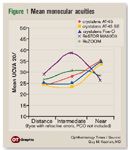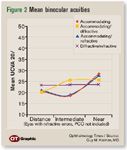Article
Mixing presbyopic IOL technologies may provide benefits
Various multifocal IOL technologies may afford better visual acuity results than implantation of a single multifocal IOL model bilaterally, but implanting an accommodating IOL (crystalens, eyeonics) and a multifocal implant in fellow eyes appears to have no advantage over bilateral implantation of the accommodating IOL, according to analyses presented by Guy M. Kezirian, MD.

Key Points
San Diego-Mixing multifocal IOL technologies may afford better visual acuity results than implantation of a single multifocal IOL model bilaterally, but implanting an accommodating IOL (crystalens, eyeonics) and a multifocal implant in fellow eyes appears to have no advantage over bilateral implantation of the accommodating IOL, according to analyses presented by Guy M. Kezirian, MD.

"Each of the presbyopia-correcting IOLs has its own strengths and weaknesses, and in an effort to derive benefits from a synergistic effect, some surgeons have advocated using these lenses in combinations. However, that approach has little clinical validation and at the same time has generated concern that patients will have difficulty resolving the two sets of optics," said Dr. Kezirian, president and founder of SurgiVision Consultants, Scottsdale, AZ.

At the time the analyses were done, more than 10,400 eyes with at least one postop exam were in the registry. The various accommodating IOL models (AT-45, AT-45 SE, and Five-O) accounted for about 85% of the implants. There were 958 eyes with the diffractive IOL (9%) implanted and 536 eyes with the refractive lens (5%).
Monocular UCVA results for each of those implants showed the benefits of the multifocal IOLs for providing better near vision, whereas all versions of the accommodating IOL offered better distance and intermediate vision than either multifocal IOL.
"Each of these IOLs has its relative strengths and weaknesses, but monocularly, none provides great vision at every distance. Keep in mind, however, when interpreting these results and the data for the bilateral mixed implantations that bilateral acuities with the same IOL can be expected to be 1 line better than monocular acuities," said Dr. Kezirian.
Patients were included in the analyses of mixing IOL technologies if they had undergone bilateral surgery with implantation of a presbyopia-correcting IOL in both eyes, had no posterior capsular opacification, and a favorable refractive result with spherical equivalent of between +0.50 D and –1.00 D and ≤0.50 D of cylinder was achieved.
"When implanting these lenses, we know that you are not done until the refraction is right," Dr. Kezirian explained.
For the binocular analyses, 46 patients had the accommodating-diffractive combination implanted, 75 patients received the diffractive-refractive combination, 396 had one model of the accommodating lens (AT-SE) implanted in both eyes, 30 patients had another model (Five-O) implanted bilaterally, 35 had the refractive lens implanted in both eyes, and 72 with the diffractive lens implanted in both eyes.




